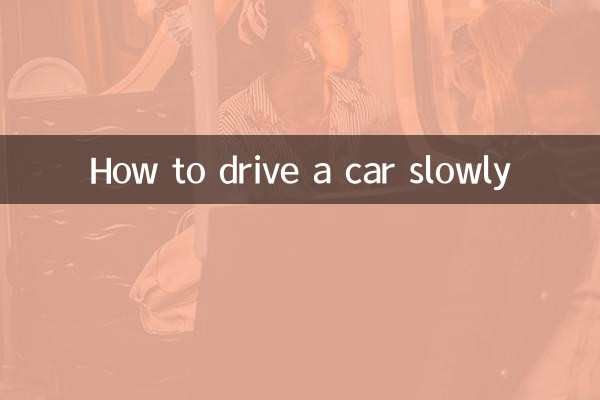How to drive a car slowly: hot topics and practical tips on the Internet in the past 10 days
In busy urban traffic, slow driving is not only an important skill for safe driving, but also a manifestation of energy conservation and environmental protection. This article will combine the hot topics on the Internet in the past 10 days to analyze the skills and precautions for slow driving, and display relevant hot content through structured data.
1. Inventory of popular car topics on the Internet in the past 10 days

| Ranking | topic | heat index | Main discussion points |
|---|---|---|---|
| 1 | Low-speed battery life optimization of new energy vehicles | 9.2/10 | How to improve cruising range by driving slowly |
| 2 | Driving skills on congested urban roads | 8.7/10 | How to follow cars slowly and keep distance between them |
| 3 | Low-speed stumbling problem in automatic transmission vehicles | 8.5/10 | Low-speed smoothness solution for CVT/DCT transmission |
| 4 | Legal requirements for slow speed driving | 7.9/10 | Minimum speed limits and penalty standards on highways |
| 5 | Idling fuel consumption test | 7.6/10 | Comparison of fuel consumption under low-speed conditions of different models |
2. Core skills for slow speed driving
1. Throttle control technology
Keep the accelerator pedal opening at a stable 10%-15% to avoid rapid acceleration. It is recommended that new energy vehicles use single pedal mode to achieve smooth deceleration through kinetic energy recovery.
2. Gearbox matching
| Gearbox type | Best low gear | Speed recommendations |
|---|---|---|
| Manual transmission | 2nd gear | 1500-2000rpm |
| AT automatic transmission | L file/S file | 1200-1800rpm |
| CVT continuously variable transmission | Analog 2nd gear | 1000-1500rpm |
3. Coping with special scenarios
•Long downhill section:Shift to low gear and use engine braking
•Rain and snow weather:Keep the speed below 30km/h and avoid sharp turns
•School area:Pay attention to the speed limit signs, usually below 20km/h
3. Precautions for driving at slow speeds
| Things to note | Specific instructions | Risk warning |
|---|---|---|
| Rear traffic warning | Turn on dual flashlights or rear fog lights | Avoid rear-end collisions |
| engine temperature | Monitor water temperature meter readings | Low speed may result in insufficient heat dissipation |
| Carbon deposition prevention | Regular high-speed cleaning | Long-term low speed is prone to carbon deposits |
4. Comparison of low-speed performance of popular models
According to recent automotive media test data, the performance of mainstream models when driving at a constant speed of 30km/h:
| car model | Noise(dB) | Fuel consumption (L/100km) | Ride rating |
|---|---|---|---|
| Toyota Corolla Hybrid | 52.3 | 3.8 | 9.1/10 |
| Volkswagen Lavida 1.5L | 54.7 | 5.2 | 8.3/10 |
| BYD Qin PLUS DM-i | 48.9 | 2.5 (power consumption) | 9.4/10 |
5. Expert advice and user feedback
Professor Wang from the Department of Automotive Engineering of Tsinghua University pointed out: "Modern automobile electronic control systems have been able to adapt well to low-speed operating conditions. Drivers should pay more attention to maintaining a reasonable distance between vehicles and predicting road conditions."
User measured data from the Autohome Forum shows:
• 80% of urban commuting scenarios have vehicle speeds below 40km/h
• Proper use of slow driving techniques can reduce fuel consumption by 15%-20%
Mastering scientific slow-speed driving methods can not only improve driving safety, but also extend the service life of the vehicle. It is recommended that drivers regularly participate in low-speed driving training, especially new energy vehicle owners who need to adapt to the motor torque output characteristics.

check the details

check the details